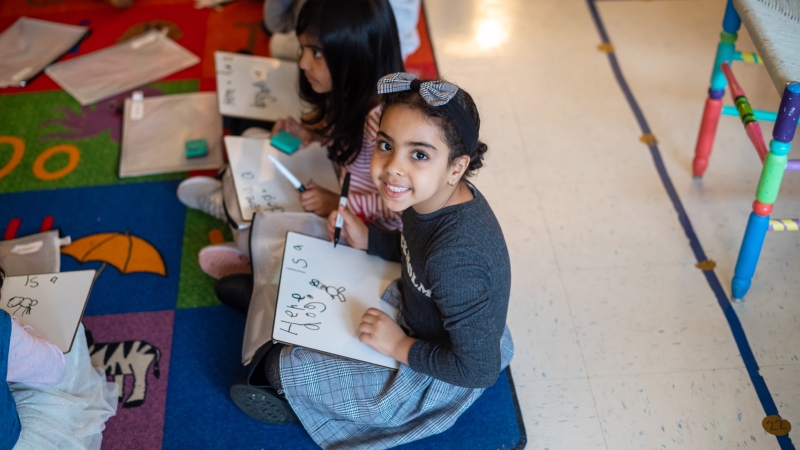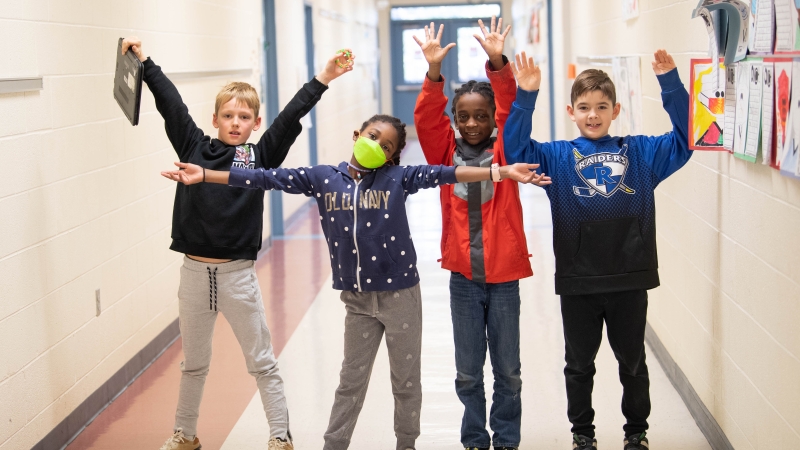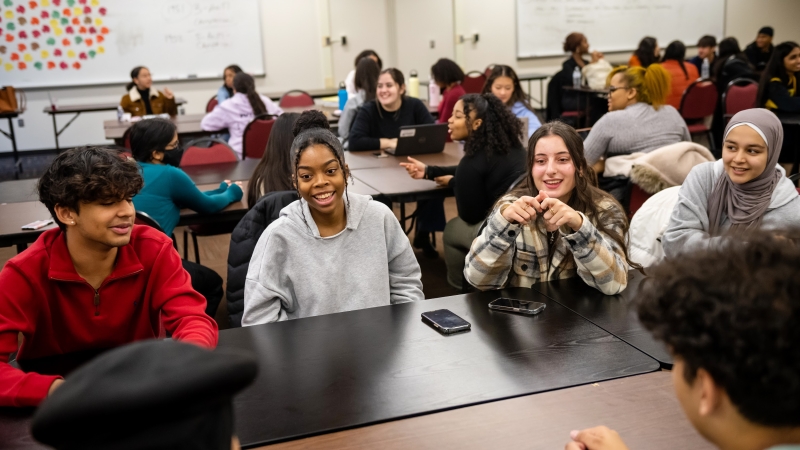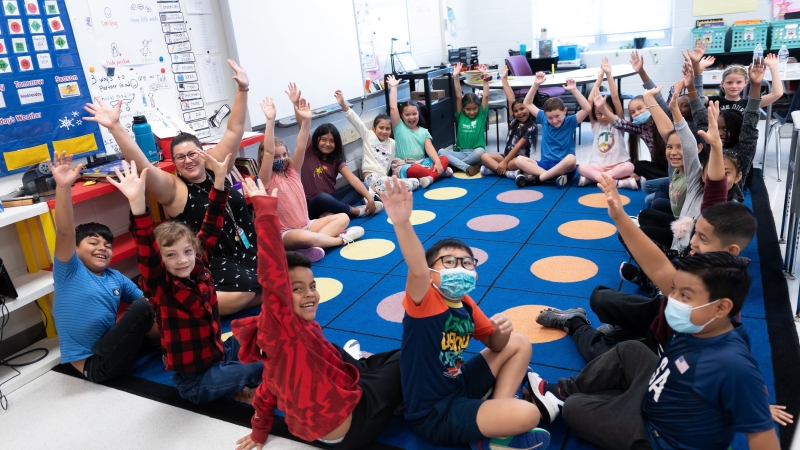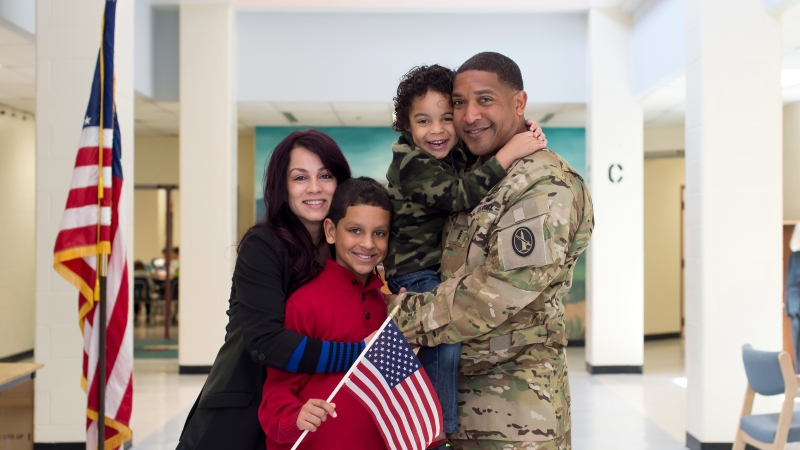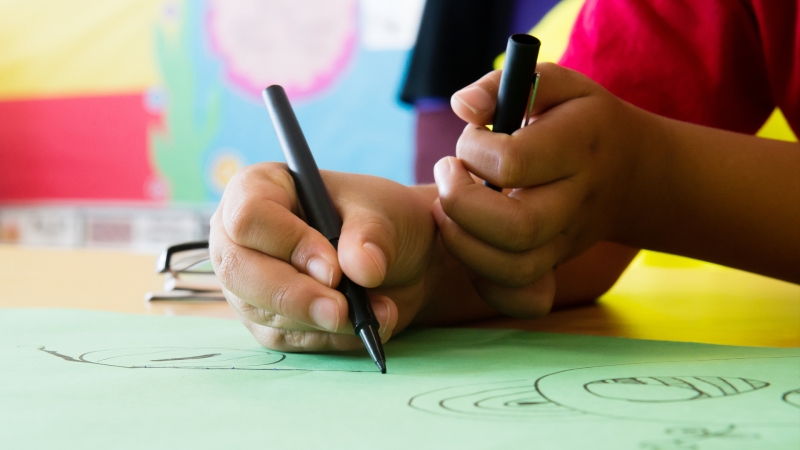
Social and Emotional Learning (SEL) in the First Six Weeks: Elementary School
Sample Morning Meetings and Closing Circles for the beginning of the school year.
This six-week calendar resource includes sample Morning Meetings and Closing Circles for the beginning of the school year, though these activities may be reused throughout the year. School teams are encouraged to adapt these activities where necessary to meet the needs of diverse learners.
Schools may also use other high-quality activities of their choosing, provided they are aligned with these practices and support SEL skill development.
The Responsive Classroom model defines Morning Meeting as an engaging way to start each day, build a strong sense of community, and set children up for success socially and academically. Each morning, students and teachers gather for 20 to 30 minutes to interact with one another during four purposeful components:
- Greeting: Students and teachers greet one other by name.
- Sharing: Students share information about important events in their lives or about the learning going on in their classrooms. Listeners often offer empathetic comments or ask clarifying questions.
- Group Activity: Everyone participates in a brief, lively activity that fosters group cohesion and helps students practice social and academic skills (for example, reciting a poem, dancing, singing, or playing a game).
- Morning Message: Students read and interact with a short message written by their teacher. The message is crafted to help students focus on the work they’ll do in school that day.
A closing circle is a positive, structured way to bring closure to the school day. Students gather for five to ten minutes to do a brief activity or reflection before dismissal.
Week 1: Intro to Morning Meeting
Morning Meeting
| Category | Directions |
|---|---|
|
Greeting |
Good Morning Wave Another Variation: Have students introduce themselves by saying and waving “Good morning! My name is [blank].” The class responds with “Good morning [blank].” and a wave. |
|
Sharing |
“What colors do you like?” or “What is your favorite color?” I like the color(s) [blank]. |
|
Activity |
Red Light, Green Light Teacher Note: Consider a red and green visual to help students understand and engage with the activity. |
|
Morning Message |
[Date] |
Closing Circle
What’s something new you learned about someone today?
Today, I learned [blank] about [blank].
Today, I learned that [blank] likes [blank].
Morning Meeting
| Category | Directions |
|---|---|
|
Greeting |
Wave Greeting
Teacher Note: Reinforce key social and emotional learning skills you want to emphasize (i.e. making eye contact, using an audible voice level, a friendly tone, using each other’s name etc.) |
|
Sharing |
Partner Share
|
|
Activity |
Just Like Me
|
|
Morning Message |
Chorally read the message. Good morning [insert grade, i.e. 3rd graders], |
Closing Circle
- Gather students back in the circle.
- Review the events of the day
- To end our day, we are going to share one thing you enjoyed during class today.
- Use the sentence stem, “Today I enjoyed[blank].”
- Have all students share out around the circle or create partnerships.
Morning Meeting
| Category | Directions |
|---|---|
|
Greeting |
Name and Motion
|
|
Sharing |
Partner Share Use sentence stem, “My favorite food is [blank].” |
|
Activity |
Would You Rather?
Teacher note: Reinforce the attention signal procedure you have established between each round. Remind students of what is expected when necessary. |
|
Morning Message |
Chorally read the message. Good morning class, |
Closing Circle
One Word Accolade
SAY: “As we end our day today, let’s form a circle and say one kind word that describes our class. I will go first, “Caring”. Turn to the student to the right, how about you, (student’s name).” If a student needs support, offer 2 words they can choose from (i.e., friendly, funny).
Morning Meeting
| Category | Directions |
|---|---|
|
Greeting |
High Five Greeting |
|
Sharing |
Partner Share |
|
Activity |
Walk and Talk
Possible topics
Teacher Note: Consider using the structure of Walk and Talk throughout the day to keep learning active and interactive. |
|
Morning Message |
Chorally read the message. Good morning listeners! |
Closing Circle
Closing Class Chant
“We are going to learn a class chant today.
We’re gonna give . . . this . . . group a hand.
We’re gonna give this group a hand. (Clap twice)
We’re gonna give . . . this . . . group a hand.
We’re gonna give this group a hand. (Clap twice)
So raise your hands up in the air, (Raise hands)
And pat your neighbor . . . right there. (Pat neighbors’ shoulders)”
Morning Meeting
| Category | Directions |
|---|---|
|
Greeting |
Good Morning Around the Circle
Teacher Note: Reinforce key social and emotional learning skills you want to emphasize (i.e. making eye contact, using an audible voice level, a friendly tone, using each other’s name etc.) |
|
Sharing |
Partner Share
|
|
Activity |
Electricity Game
|
|
Morning Message |
Highlight the word “electrifying” in the message. Ask for a volunteer to come up with a motion for the word electrifying. Read the message chorally or to students and have everyone show the motion when you come across the word. Good morning class, |
Closing Circle
2 Minute Closing
- SAY: “What an amazing week it has been! We have learned a little about each other in our class. We’ll take two minutes for our closing activity today, and within those two minutes say goodbye to as many of your peers as you can. You will wave goodbye to each person and use their name.”
Teacher Note: Model what it will look and sound like to safely move around the room and say goodbye to others (i.e. staying calm, walking, stopping and facing the person you are greeting, etc.)
Week 2: Intro to Morning Meeting
Morning Meeting
| Category | Directions |
|---|---|
|
Greeting |
Rainbow Wave |
|
Sharing |
SAY: Rainbows come out after it rains. What is your favorite type of weather? My favorite weather is [blank]. Teacher Note: Post pictures with labels on a google slide to give students a visual. |
|
Activity |
Pop! Teacher Note: You can also keep the count going and stop at multiples (i.e. multiples of 5–5, 10, 15, 20). |
|
Morning Message |
[Date] |
Closing Circle
“Today, I saw [blank] greet a friend/teacher in the hallway using the rainbow wave. Who else greeted someone with a quiet wave?”
Morning Meeting
| Category | Directions |
|---|---|
|
Greeting |
Knock, Knock Greeting |
|
Sharing |
Turn to your partner and finish this sentence in 5 words or less. “This morning I [blank].” Optional: Give students a few examples or have a student volunteer offer an example. (i.e. “This morning I hugged my dog.”; “This morning I wanted to sleep longer”, “This morning I made breakfast for my brother”). Having students count words on their fingers is also helpful. |
|
Activity |
20 Questions Lower Grades
Upper Grades
|
|
Morning Message |
Good morning detectives, |
Closing Circle
Around-the-circle
“Share one thing you learned today.”
Use the sentence stem: Today I learned [blank].
Morning Meeting
| Category | Directions |
|---|---|
|
Greeting |
Shake It Greeting
|
|
Sharing |
Class Brainstorm
Teacher Note: Use reinforcing language on things you noticed while partners were talking. For example, “I noticed partners saying, “looking at each other to show they were listening” or “I noticed partners taking turns talking.” |
|
Activity |
One, Two, Three Clap Round 1:
Round 2:
Additional Rounds (If desired) Round 3:
|
|
Morning Message |
Good morning team, |
Closing Circle
The first student will turn to their right and say “Good job today!” Continue around the circle.
Morning Meeting
| Category | Directions |
|---|---|
|
Greeting |
The Weekend is Near Chant “Hello, (student name). The weekend is near! What are you going to do when it’s here? Student 1: Hello, everyone! I’m going to [blank]!” Group: Have fun! Group greets the next person, and continues this pattern around the circle until everyone has been greeted. |
|
Sharing |
Partner Share “What is your favorite summer activity?” My favorite summer activity is [blank]. Optional: have a slide with pictures of different summer activities. |
|
Activity |
Hot Potato Game Materials needed:
Instructions:
|
|
Morning Message |
Good morning friendly students, |
Closing Circle
Around the Circle Share
“Take turns sharing one way you will relax this weekend.”
Week 3: Relationship Building
Morning Meeting
| Category | Directions |
|---|---|
|
Greeting |
Saying “Hello” in a different language. Students will greet each other with “hello” in a language other than English (adapt to include some of the languages represented in your classroom. Examples: Hola (Spanish), Konnichiwa ( Japanese), Privet (pree-vee-yet) (Russian), Bonjour (French), Ciao (Italian) Teacher Note: consider giving students a signal to indicate they have already been greeted (i.e. crossing your arms) |
|
Sharing |
Partner Share: “What is your favorite animal?” My favorite animal is [blank]. Have students figure out 1 way their animals are similar and different. |
|
Activity |
Red Light, Green Light |
|
Morning Message |
Welcome back [blank] graders! |
Closing Circle
“I am curious about [blank]” At the end of an engagement, participants are asked to reflect on something that they are curious about as a result of their day/meeting/lesson. They will then share their reflection with a partner or with their table group.
What was something you were curious about today?
Morning Meeting
| Category | Directions |
|---|---|
|
Greeting |
Nonverbal Greeting
Teacher Note: use reinforcing language after activity based on what you saw. Examples might include: walking, greeting lots of different peers, facing the person being greeted etc. |
|
Sharing |
Partner Share “How can you tell if someone is happy? How can you tell if someone is upset?” Optional: share out a few ideas with the whole class |
|
Activity |
Emotion Charades This can be played as a whole group or in smaller groups.
|
|
Morning Message |
Good morning class, |
Closing Circle
Clock Partner Share
- SAY: “Today we learned more about how our bodies can show or communicate feelings to others.”
- Give students a partner or use clock partners
- Ask: “What types of body cues or body language did you notice in yourself or in others today?” Give students a couple minutes to talk.
- Tell students to give their partner a non-verbal signal to communicate “good job!” (i.e. model thumbs up, ok sign, smile, bow, etc.)
Morning Meeting
| Category | Directions |
|---|---|
|
Greeting |
Name and Motion - Feelings Edition
|
|
Sharing |
Partner share |
|
Activity |
Back to Back: An activity to build self awareness and communication. Materials: Paper, coloring utensils, and pictures of random objects. Give each group pictures so they can randomly choose what to describe to their partner.
Ask students about their communication during the activity. What was helpful? Were there any issues with communication you had to work through? Allow 2-3 students to share. |
|
Morning Message |
Good morning communicators! |
Closing Circle
Clock Partner Share
- SAY: Today we learned more about communicating with others and many other wonderful things.
- Assign partners or use clock partners
- Have partnerships discuss the following question: How will you be a good communicator the rest of this week?
Morning Meeting
| Category | Directions |
|---|---|
|
Greeting |
Birthday Greeting
|
|
Sharing |
Partner Share |
|
Activity |
Mix and Mingle Materials: Paper, writing utensils, sentence starter, access to music that can be turned on and off easily
Teacher Notes:
|
|
Morning Message |
Greetings Caring Class! |
Closing Circle
Mix and Mingle
Use the Mix and Mingle structure that was learned during the Morning Meeting activity to have partners discuss the following question: What can you try next week to continue communicating kindly with others?
Week 4: Relationship Building
Morning Meeting
| Category | Directions |
|---|---|
|
Greeting |
Each student writes a positive note or hello message on a piece of paper, crumbles it up, and then throws it across the room. Everyone opens one positive message. Teacher Note: consider giving students a signal to indicate they have already been greeted (i.e. crossing your arms) |
|
Sharing |
Students will share a book or cartoon character they like and why. Brainstorm some different characters with students and reasons why people might like them. Provide think time, and then model how students will share using this sentence: “A character I like is [blank] because [blank].” Give every student an opportunity to share. Remind students of the silent signal they learned on Day 1 to show that they connect with something another student is sharing. |
|
Activity |
Let students know that they’re going to do the pantomime activity again, but this time with an animal. Give them a minute to think of an animal and a simple movement they can do to represent that animal (for example, swinging both arms from side to side for an elephant). Ask for a student volunteer to begin and show their movement. Remind students to wait until the pantomime is finished before they raise their hand to guess. Allow for up to three guesses. Try several rounds. |
|
Morning Message |
[Date] |
Closing Circle
Reflect on three good things that happened today, as a class.
Morning Meeting
| Category | Directions |
|---|---|
|
Greeting |
Hullabaloo Post a chart with 3 columns and 5 rows:
|
|
Sharing |
Around the Circle Share |
|
Activity |
What’s New?
|
|
Morning Message |
Good morning listeners, |
Closing Circle
“What do you want to remember about today’s class?”
Morning Meeting
| Category | Directions |
|---|---|
|
Greeting |
Day 2 of Hullabaloo Post the same chart as yesterday or create the new one below:
|
|
Sharing |
Partner Share |
|
Activity |
Grounding Exercise
|
|
Morning Message |
Good morning peaceful students! |
Closing Circle
News Headline
- Lower grades
- Brainstorm or give students a list of words someone might use to describe their day
- Examples might include: beautiful, nice, calm, long, happy, tiring, pleasant, hard, busy, fast, quiet, loud etc..
- Have students share around the circle one word that describes their day
- Brainstorm or give students a list of words someone might use to describe their day
- Upper Grades
- Explain to students that a news headline is descriptive, short and catchy to attract a reader. Some examples might be:
- Olympians Get Creative when Training!
- At Just 17, Olympian Lydia Jacoby Wins Gold
- NYC is New Location for Bruce Springsteen Concert
- What is a news headline you could use to describe today’s class? Give students a minute to think and then share around the circle
- Explain to students that a news headline is descriptive, short and catchy to attract a reader. Some examples might be:
- Optional: have students share and brainstorm with a partner first before going around the circle
Morning Meeting
| Category | Directions |
|---|---|
|
Greeting |
Say Your Name
|
|
Sharing |
Partner Share Optional: give students a few examples, make a list of statements for students to see, and then have students choose one encouraging statement to share as you go around the circle. Examples might include:
|
|
Activity |
Brain Break Materials needed: mindfulness bell, online tone, etc.
Teacher note: Oftentimes our bodies can be present but our minds are elsewhere. Asking participants to focus on a simple action helps everyone become fully present. |
|
Morning Message |
Good morning mindful learners, |
Closing Circle
Mindful Minute and Partner Share
- Complete another “Mindful Minute” as the students learned from the activity during Morning Meeting.
- Share with a partner ways they can stay present and focused tomorrow.
Morning Meeting
| Category | Directions |
|---|---|
|
Greeting |
Doing the Wave
|
|
Sharing |
Partner or Around the Circle Share |
|
Activity |
Positive Affirmation!
|
|
Morning Message |
Happy Friday positive class! |
Closing Circle
I am Connected
- Stand up.
- Place both hands on your heart and then extend your arms out wide to your sides. Feel the stretch in your arms and back.
- Repeat 5 times and on the last time, the whole class says, “I am connected!”
Week 5: Help-Seeking Behavior
Morning Meeting
| Category | Directions |
|---|---|
|
Greeting |
Good Morning Claps Teacher Note: consider giving students a signal to indicate they have already been greeted (i.e. crossing your arms) |
|
Sharing |
What are ways that we can be helpful to others? |
|
Activity |
What are some ways that we can help others? Draw a picture and/or write a sentence about how you can help others. |
|
Morning Message |
Good morning helpful [blank] graders! |
Closing Circle
How were you helpful today? Who helped you today?
I was helpful by [blank].
[blank] helped me with [blank].
Morning Meeting
| Category | Directions |
|---|---|
|
Greeting |
Action Greeting
|
|
Sharing |
Around the Circle Share SAY: “This week we are focusing on ways to help ourselves and each other. Who is someone you like to ask for help when you need it?” |
|
Activity |
Mental Vacation
|
|
Morning Message |
Good morning helpers! |
Closing Circle
Commonalities
- The leader (you or a student) stands in the center of the circle. Everyone else sits.
- The leader says a statement about something positive that happened that day, such as “I learned something new today.”
- Everyone to whom that statement applies stands.
- Before beginning, tell students to notice the similarities and differences between classmates.
- Play a few rounds.
Morning Meeting
| Category | Directions |
|---|---|
|
Greeting |
Follow the Leader
Teacher Note: This is a movement filled greeting. Use interactive modeling to set up your class for success. Expectations to consider sharing with the class might include: staying in their own space while moving or motions that everyone will be able to do. |
|
Sharing |
Partner Share |
|
Activity |
When do I need help? Materials: Paper and writing utensils (optional)
Teacher Note: The lists generated in this activity can be used to support activities on Thursday and Friday of this week. |
|
Morning Message |
Good morning Helpful Students! |
Closing Circle
Circle of Hands
- Students stand with their right arm extended toward the middle of the circle. Their left arm stays down by their side. Make a fist with their right hand, palm side down, and extend their thumb. They put their thumb inside the fist of the person to their left, creating a large, tight circle.
- The class does a quick cheer, such as “Go team” while raising all arms up in the air and then breaking apart.
- Variations:
- Different cheers: Wow! Yay, friends! Good night! Peace out!
- Social Distancing: Make the circle without actually touching each other’s hands
Morning Meeting
| Category | Directions |
|---|---|
|
Greeting |
Closed Eye Greeting
Teacher Note: Consider sharing expectations with the class (i.e. “once you make eye contact with someone, greet them, even if it is not your best friend. If you notice a student has not been greeted, try to include them in the next round.”) |
|
Sharing |
Partner Share |
|
Activity |
Asking For Help Materials: Display a list of steps, digitally or written.
|
|
Morning Message |
Good morning class, |
Closing Circle
Farewell Snake
- Student 1 steps inside the circle, turns to student 2 on their left, and says goodbye to them.
- Student 1 continues walking around the circle saying goodbye to each classmate.
- Student 2 follows behind student 1, also saying goodbye to each classmate.
- The inside line grows as each student follows by joining the end of the line and saying goodbye to everyone in the circle.
- Students line up to leave the classroom or return to their original spot (tell them in advance)
Morning Meeting
| Category | Directions |
|---|---|
|
Greeting |
Ball Toss Greeting Materials: A ball suitable for tossing (stress ball, foam ball, etc.)
Teacher Note: consider giving students a signal to indicate they have already been greeted (i.e. crossing your arms) |
|
Sharing |
Around the Circle Share |
|
Activity |
Asking For Help Check In Materials needed: Painters tape or signs to designate three areas.
Teacher Note: Use interactive modeling to show how to safely walk around the classroom when students are moving in different directions. Consider also modeling how to say “excuse me.” |
|
Morning Message |
Greetings Learners! |
Closing Circle
The Weekend is Near (call and response)
Group: Hello [name of child being greeted]!
The weekend is near [Group waves while chanting]
What are you gonna do [Group points to the person being greeted]
When it really gets here? [Group points down at the floor]
Child being greeted: I’m gonna [action] [action] [action] (Child names and pantomimes one action three times)
Group: He’s gonna [action] [action] [action] (Group repeats and pantomimes same action three times)
Week 6: Help-Seeking Behavior
Morning Meeting
| Category | Directions |
|---|---|
|
Greeting |
Good Morning Greeters Teacher Note: consider giving students a signal to indicate they have already been greeted (i.e. crossing your arms) |
|
Sharing |
Partner Share |
|
Activity |
Mindful Breathing |
|
Morning Message |
Good morning class! |
Closing Circle
Practice an animal breathe from Morning Meeting. When it is over, have the class say “Goodbye class!” on the count of 3.
Morning Meeting
| Category | Directions |
|---|---|
|
Greeting |
Ball Toss Greeting day 2
Teacher Note: For the variation, ask students how they can be respectful if someone drops the ball? Share some ideas if they have not already been said (i.e. saying “good try” or “that's okay!”) |
|
Sharing |
Partner Share |
|
Activity |
One, Two, Three Clap Round 1:
Round 2:
Additional Rounds (If desired) Round 3:
|
|
Morning Message |
Good morning class! |
|
Closing Circle |
|
|
Words of Encouragement
|
Morning Meeting
| Category | Directions |
|---|---|
|
Greeting |
Say Your Name
|
|
Sharing |
Partner Share Teacher Note: As partners chat, reinforce key listening skills that you notice. |
|
Activity |
Quote
|
|
Morning Message |
Good morning preserving students! |
Closing Circle
Around the Circle Share
“Take turns saying something that you appreciated about today.”
Morning Meeting
| Category | Directions |
|---|---|
|
Greeting |
Compliment Greeting
Teacher note: Connecting compliments to how a student followed your classroom rules, might help teach how to give a compliment that is not based on their appearance. |
|
Sharing |
Around the Circle Share |
|
Activity |
What Makes You Happy?
|
|
Morning Message |
Good morning kind students! |
Closing Circle
One-Word Whip Around
“Share one word that sums up your learning for today.”
